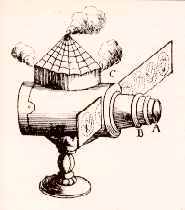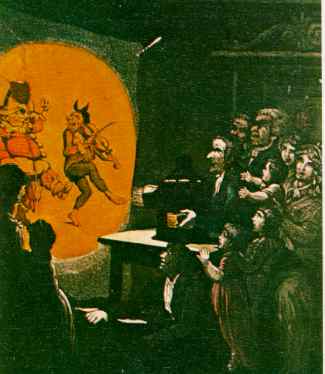

About Magic Lanterns.
The origins of the magic lantern can be traced back to the mid-1600s, almost two hundred years before the first photographs were made. On 19 August 1666 an Englishman, Samuel Pepys, wrote in his now-famous diary, ‘Comes by agreement Mr Reeves [bringing] a lanthorn, with pictures in glasse, to make strange things to appear on the wall, very pretty.’ Pepys was so impressed by the demonstration he bought the lantern and two telescopes. On 22 August he noted settling his account for ‘the lanthorn that shows tricks.’ This must have been the earliest recorded sale of a slide projector.
 |
Left: Illustration of a magic lantern that was published about 300 years ago, which was 150 years before the first photographs were made. The horizontal glass slide contains a series of circular hand-painted pictures which are illuminated by a very smoky oil lamp. |
From its rudimentary beginings the lantern was steadily improved as science and technology advanced. Better lamps were made, reflectors and condenser lenses added, projection lenses became sharper and brighter, and photographic slides replaced the old hand-painted pictures.
In the menu at the left The Lanterns will take you to a section dealing with the mechanical aspects of the instrument, and where the information is available South Australian examples are given.
The Phantasmagoria section deals with an application of the magic lantern which was the forerunner of today’s horror films and video nasties.
The many types of hand painted and photographically produced Lantern Slides are dealt with in that section, including the ‘Man Eating Rats’ mechanical slide that was so popular in the 19th century, and the Chromatropes that produced startling and beautiful colour effects like the ‘Chinese Fireworks.’
Sources of Light covers the various types of illumination used in magic lanterns, from the Argand lamp to the powerful but dangerous limelight which used highly inflammable and explosive gases such as ether, acetylene, hydrogen and oxygen. Twice in the 1860s oxygen-making equipment being used in Adelaide exploded with violent and disastrous results.
Numerous descriptions of the Lanternists and Lantern Shows are given in this section, including some of the venues used, with more under construction.
While the Moving Panoramas and Dioramas were not of a photographic nature, they were in many ways similar to a magic lantern show. Large paintings on canvas were wound across the stage of the theatre, accompanied by lighting and sound effects. One panorama shown in Adelaide had paintings 25 feet long by 14 feet high which formed a canvas that was 3,000 feet long.
 |
Left: Early magic lantern pictures were usually in the form of a disc of light projected on a linen sheet, and because the lamps were burning oil the pictures were of an orange or yellowish colour, as shown in this illustration. |
End.